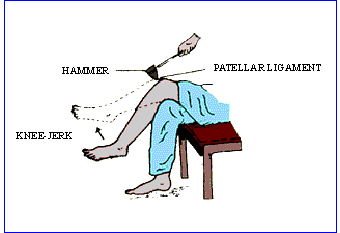|
|
|
In all such actions, the impulses are carried to
and from the spinal cord In other words a reflex action is
an involuntary action and there is no choice as to whether the action
should take place or not.
Many of the reflexes are innate, and are called
unconditional or inherited reflexes. These reflexes
are few in number and do not depend on a prior experience. Previous
experiences establish conditioned or acquired reflexes.
They are much more in number and develop due to environmental changes.
The conditioned reflex is one way in which animal and humans learn.
In all reflex actions, the spinal cord forms the
main path for the impulses, from and to the brain.
Reflex actions have survival value.

Figure 23.9 Knee jerk reflex
SUMMARY
|
(1) The nervous system together with the
endocrine system coordinates body activities. (2)The control
center of the nervous system is the brain which has three
divisions, i.e. forebrain, midbrain and hindbrain. (3) The
forebrain consists of cerebrum thalamus and hypothalamus.
The midbrain has decreased in size during vertebrate evolution,
and the forebrain has gradually acquired much of its function,
while the hindbrain consists of medulla, cerebellum and the
pons. (4) The spinal cord is the main path for conduction
of nervous and is a reflex center. (5) Of the 12 cranial nerves,
11 cranial nerves control the head, and 1 cranial nerve communicates
between the brain and the internal organs. There are 31 pairs
of spinal nerves. (6) The sympathetic nerves produce the fight-or-flight
response during times of stress. The parasympathetic nerves
help to maintain homeostasis, to recover from stress. (7)
The reflex action is automatic, a sudden response to a stimulus.
The stimulus follows a path from the receptor to the effector
organ called a reflex arc.
|
|
**********
|
Table of Contents
23.0 Introduction
23.1 Central nervous system
23.2 The automatic nervous system
23.3 Receptors and effects
23.4 Reflex action - mechanism of nervous action
Chapter 24
|